Abstract
In order to control the systematic divergence among decision makers (DMs) and preserve the original decision preference, this paper proposes a novel decision information fusion framework under the hesitant fuzzy environment. First, a maximum compactness-based normalization method is presented to normalize hesitant fuzzy elements (HFEs) as pretreatment of decision data. Second, prospect theory is introduced to assign the optimal aggregation weights to maximize the efficiency of the preference aggregation process, in which the expected consensus threshold is viewed as a reference point estimated through statistic inference to distinguish DMs’ status. Third, an effective feedback mechanism is designed to improve group consensus, and the dichotomy algorithm is utilized to search optimal feedback weight to preserve original decision information. Finally, a case study and comparison analysis are illustrated to show the efficiency of the proposed hesitant fuzzy information fusion method.






Similar content being viewed by others
Explore related subjects
Discover the latest articles and news from researchers in related subjects, suggested using machine learning.References
Antonio, S., Humberto, B.: A wrapper methodology to learn interval-valued fuzzy rule-based classification systems. Appl. Soft Comput. 104, 107249 (2021)
Rong, Y., Liu, Y., Pei, Z.: Interval-valued intuitionistic fuzzy generalized bonferroni mean operators for multi-attribute decision making. Int. J. Fuzzy Syst. 4, 1–27 (2021)
Zhao, M., Wei, G., Wei, C., Wu, J.: Pythagorean fuzzy todim method based on the cumulative prospect theory for magdm and its application on risk assessment of science and technology projects. Int. J. Fuzzy Syst. 2, 1–15 (2021)
Liao, N., Wei, G., Chen, X.: Todim method based on cumulative prospect theory for multiple attributes group decision making under probabilistic hesitant fuzzy setting. Int. J. Fuzzy Syst. 7, 1–18 (2021)
Zhang, Z.M., Chen, S.: Group decision making based on acceptable multiplicative consistency and consensus of hesitant fuzzy linguistic preference relations. Inf. Sci. 541, 531–550 (2020)
Zhong, X.Y., Xu, X.H.: Clustering-based method for large group decision making with hesitant fuzzy linguistic information: Integrating correlation and consensus. Appl. Soft Comput. 87, 105973 (2020)
Xu, Y.J., Wen, X.W., Sun, H., Wang, H.M.: Consistency and consensus models with local adjustment strategy for hesitant fuzzy linguistic preference relations. Int. J. Fuzzy Syst. 20, 2216–2233 (2018)
Zhou, X.Y., Wang, L.Q., Liao, H.C., Wang, S.Y., Fujita, H.: A prospect theory-based group decision approach considering consensus for portfolio selection with hesitant fuzzy information. Knowl.-Based Syst. 168, 28–38 (2018)
Liu, X., Xu, Y.J., Montes, R., Dong, Y.C., Herrera, F.: Analysis of self-confidence indices-based additive consistency for fuzzy preference relations with self-confidence and its application in group decision making. Int. J. Intell. Syst. 34, 920–946 (2019)
Xu, Y.J., Cabrerizo, F., Herrera-Viedma, E.: A consensus model for hesitant fuzzy preference relations and its application in water allocation management. Appl. Soft Comput. 58, 265–284 (2017)
Yager, R.R.: Quantifier guided aggregation using owa operators. Int. J. Intell. Syst. 11, 49–73 (1996)
Zhang, B.W., Liang, H.M., Zhang, G.Q.: Reaching a consensus with minimum adjustment in magdm with hesitant fuzzy linguistic term sets. Information Fusion 42, 12–23 (2017)
Liu, N.N., He, Y., Xu, Z.S.: A new approach to deal with consistency and consensus issues for hesitant fuzzy linguistic preference relations. Appl. Soft Comput. 76, 400–415 (2019)
Xiao, J., Wang, X., Zhang, H.J.: Managing classification-based consensus in social network group decision making: An optimization-based approach with minimum information loss. Information Fusion 63, 74–87 (2020)
Zhang, Z.M., Pedrycz, W.: A consistency and consensus-based goal programming method for group decision-making with interval-valued intuitionistic multiplicative preference relations. IEEE Transactions on Cybernetics 49, 3640–3654 (2019)
Mohammadi, M., Rezaei, J.: Ensemble ranking: Aggregation of rankings produced by different multi-criteria decision-making methods. Omega 96, 102254 (2020)
Mohammadi, M., Rezaei, J.: Bayesian best-worst method: A probabilistic group decision making model. Omega 96, 102075 (2020)
Wan, S.P., Zhong, L., Dong, J.Y.: A new method for group decision making with hesitant fuzzy preference relations based on multiplicative consistency. IEEE Trans. Fuzzy Syst. 99, 1–12 (2019)
Wu, P., Liu, J.P., Zhou, L.G., Chen, H.Y.: Algorithm for improving additive consistency of linguistic preference relations with an integer optimization model. Appl. Soft Comput. 86, 105955 (2020)
Cao, M.S., Wu, J., Chiclana, F., Urena, R., Herrera-Viedma, E.: A personalized consensus feedback mechanism based on maximum harmony degree. IEEE Transactions on Systems, Man, and Cybernetics: Systems 243, 713–721 (2019)
Pérez, I., Cabrerizo, F., Alonso, S., Dong, Y., Chiclana, F., Herrera-Viedma, E.: On dynamic consensus processes in group decision making problems. Inf. Sci. 459, 20–35 (2018)
Tang, M., Zhou, X.Y., Liao, H.C., Xu, J.P., Fujita, H., Herrera, F.: Ordinal consensus measure with objective threshold for heterogeneous large-scale group decision making. Knowl.-Based Syst. 180, 62–74 (2019)
Ben-Arieh, D., Easton, T.: Multi-criteria group consensus under linear cost opinion elasticity. Decis. Support Syst. 43, 713–721 (2007)
Zhang, H.J., Dong, Y.C., Chiclana, F., Yu, S.: Consensus efficiency in group decision making: A comprehensive comparative study and its optimal design. Eur. J. Oper. Res. 275, 580–598 (2018)
Wu, Z.B., Huang, S., Xu, J.P.: Multi-stage optimization models for individual consistency and group consensus with preference relations. Eur. J. Oper. Res. 275, 182–194 (2018)
Xiao, J., Wang, X., Zhang, H.J.: Managing personalized individual semantics and consensus in linguistic distribution large-scale group decision making. Information Fusion 53, 20–34 (2019)
Zhang, B.W., Dong, Y.C., Zhang, H.J., Pedrycz, W.: Consensus mechanism with maximum-return modifications and minimum-cost feedback: A perspective of game theory. Eur. J. Oper. Res. 287, 546–559 (2020)
Liu, X., Xu, Y.J., Montes, R., Ding, R.X., Herrera, F.: Alternative ranking-based clustering and reliability index-based consensus reaching process for hesitant fuzzy large scale group decision making. IEEE Trans. Fuzzy Syst. 27, 159–171 (2019)
Du, Z.J., Yu, S.M., Xu, X.H.: Managing noncooperative behaviors in large-scale group decision-making: Integration of independent and supervised consensus-reaching models. Inf. Sci. 531, 119–138 (2020)
Gou, X.J., Xu, Z.S., Liao, H.C., Herrera, F.: Consensus model handling minority opinions and noncooperative behaviors in large-scale group decision-making under double hierarchy linguistic preference relations. IEEE Transactions on Cybernetics 99, 1–14 (2020)
Torra, V.: Hesitant fuzzy sets. Int. J. Intell. Syst. 25, 529–539 (2010)
Xia, M.M., Xu, Z.S.: Hesitant fuzzy information aggregation in decision making. Int. J. Approximate Reasoning 52, 395–407 (2011)
Zhang, X.L., Xu, Z.S., Wang, H.: Heterogeneous multiple criteria group decision making with incomplete weight information: A deviation modeling approach. Information Fusion 25, 49–62 (2015)
Chao, X.R., Kou, G., Peng, Y., Viedma, E.H.: Large-scale group decision-making with non-cooperative behaviors and heterogeneous preferences: An application in financial inclusion. Eur. J. Oper. Res. 288, 271–293 (2020)
Zhu, B., Xu, Z., Xu, J.: Deriving a ranking from hesitant fuzzy preference relations under group decision making. IEEE Transactions on Cybernetics 44, 1328–1337 (2013)
Xu, Z.S., Xia, M.M.: Distance and similarity measures for hesitant fuzzy sets. Inf. Sci. 181, 2128–2138 (2011)
Tversky, K.: Prospect theory: An analysis of decision under risk. Econometrica 47, 263–291 (1979)
Wu, A.P., Li, H., Dong, M.: A novel two-stage method for matching the technology suppliers and demanders based on prospect theory and evidence theory under intuitionistic fuzzy environment. Appl. Soft Comput. 95, 106553 (2020)
Wang, Z.L., Wang, Y.M.: Prospect theory-based group decision-making with stochastic uncertainty and 2-tuple aspirations under linguistic assessments. Information Fusion 56, 81–92 (2020)
Li, J., Wang, J.Q., Hu, J.H.: Consensus building for hesitant fuzzy preference relations with multiplicative consistency. Comput. Ind. Eng. 128, 387–400 (2018)
Kazmaier, J., Vuuren, J.: A generic framework for sentiment analysis: Leveraging opinion-bearing data to inform decision making. Decis. Support Syst. 135, 113304 (2020)
Acknowledgements
This work was supported by the Grant (Nos.71971117) from NSF of China and the Grant (Nos.17YJA630035) from the Chinese Ministry of Education.
Author information
Authors and Affiliations
Corresponding author
Rights and permissions
About this article
Cite this article
Tao, X., Jiang, W. Research on Two-Stage Hesitate Fuzzy Information Fusion Framework Incorporating Prospect Theory and Dichotomy Algorithm. Int. J. Fuzzy Syst. 24, 1530–1547 (2022). https://doi.org/10.1007/s40815-021-01207-6
Received:
Revised:
Accepted:
Published:
Issue Date:
DOI: https://doi.org/10.1007/s40815-021-01207-6




